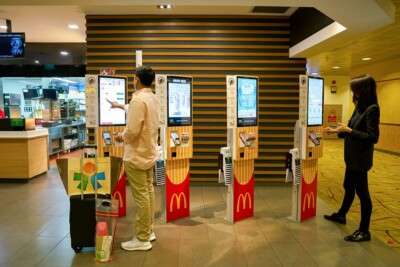Types of Digital Signage

Outdoor Digital Signage
Indoor Digital Signage
Interactive Digital Signage
Menu Boards
Video Walls
Direct View LED
Smartphone-like Touchscreens
Benefits of Digital Signage
Digital signage offers a multitude of advantages that enhance marketing efforts and improve customer experiences across various industries. These benefits include increased engagement, real-time updates, and personalized content delivery.
Enhanced Customer Engagement

Real-Time Content Updates

Targeted Messaging

Customization and Personalization

Metrics and Performance Tracking

Trends in Digital Signage
Dynamic Content Delivery
Integration with Analytics
Interactivity and Engagement
Real-Time Content Updates
Personalization
Enhanced Brand Storytelling
Case Studies
Digital signage has demonstrated significant advantages across various sectors, showcasing its adaptability and effectiveness in enhancing customer engagement and streamlining operations. This section highlights notable case studies that illustrate the impactful application of digital signage solutions
Retail Environments
Adidas Pop-Up Store

Adidas implemented eye-catching digital signage content in a pop-up store that successfully attracted higher foot traffic and increased sales. The use of interactive mirrors and engaging product displays transformed the shopping experience, making it memorable for customers. Moreover, real-time marketing capabilities allowed Adidas to adjust promotions swiftly based on customer preferences and market trends, generating social media buzz through user-generated content
McDonald's Touchscreen Kiosks

McDonald's installed large touchscreen digital signage kiosks in strategic locations within their restaurants. These user-friendly interfaces showcased vivid menu imagery, nutritional information, and customization options. This innovation improved order accuracy, allowing customers to browse and select their choices easily, resulting in fewer order errors and enhanced customer satisfaction
Corporate Environments CHRIST University
CHRIST University modernized its campuses using Pickcel's digital signage software, which significantly improved internal communication and information accessibility for students and faculty. This implementation streamlined communication channels and enhanced the overall campus experience by ensuring that important announcements and updates were readily available to the university community
Saudi Investment and Resource Company (SIRC)
SIRC collaborated with Pickcel to enhance employee engagement and internal communication. By utilizing digital signage solutions, the company was able to convey important messages effectively, fostering a more connected workplace environment and improving overall employee satisfaction
Event Management WAM Global Events
WAM Global Events, based in Dubai, successfully integrated digital signage to deliver unique event experiences. This approach provided attendees with real-time updates and information, significantly enhancing their overall experience and engagement during events.
Financial Services
TerraPay
TerraPay, a global payment infrastructure company, utilized digital signage to improve customer engagement and enhance the visibility of its services. This strategic application not only increased awareness but also helped in bridging the gap in financial inclusion. These case studies highlight the diverse applications of digital signage in various industries, demonstrating its role in enhancing customer experiences, improving operational efficiency, and fostering better internal communication.
Challenges and Considerations
Theoretical and Empirical Limitations Despite the growing body of research on digital signage, significant theoretical and empirical limitations exist. Most studies have concentrated on specific behavioral outcomes, primarily focusing on anti-litter behavior, which raises questions about the generalizability of findings to other signage domains. Furthermore, existing literature predominantly addresses "whether" and "what type" of signs influence behavior, leaving the "how" largely unexplored. This gap indicates a need for more in-depth investigations into the psychological mechanisms that underpin how signage affects audience behavior.
Research Gaps
Current studies have identified various outcomes, such as consumer engagement metrics, but there is still a need for comprehensive research that integrates these measures with actual observed behavior. For example, while perceived effectiveness has been cited as an important factor in health messaging, its applicability in other contexts remains underexplored. Future research could benefit from utilizing both lab and field settings to test hypotheses about signage efficacy in real-world scenarios.
Installation and Maintenance Considerations
When implementing digital signage, organizations must weigh the costs of installation and ongoing maintenance. Depending on the system's complexity, professional installation may be necessary, adding one-time costs that vary based on installation methods. Furthermore, ongoing expenses related to software updates, hardware maintenance, and staff training should be considered. Proper training is essential for effective use of digital signage software and hardware, ensuring that all employees can maximize the technology's potential.
Cost-Benefit Analysis
Organizations must conduct a thorough cost-benefit analysis to evaluate the expected return on investment (ROI) from digital signage. Although hardware costs have decreased significantly, the expenses associated with content creation can still be substantial. For instance, companies may find themselves investing millions in content alongside hardware expenditures. Thus, balancing initial investment with long-term benefits is crucial for successful implementation.
Strategic Placement
The effectiveness of digital signage heavily depends on its placement. Analyzing foot traffic patterns and ensuring that signage is positioned at eye level can greatly enhance visibility and engagement. A well-thought-out placement strategy is vital for maximizing the impact of digital signs, as improper placement can lead to wasted resources and missed opportunities for consumer engagement.
Integration with Existing Systems
Another challenge lies in ensuring that new digital signage solutions integrate seamlessly with existing business processes and technologies. Organizations must involve key stakeholders in the decision-making process to ensure that selected software and hardware meet the needs of various departments. Assessing compatibility with current systems is crucial for a smooth implementation, as technical issues can inhibit the effectiveness of digital signage campaigns.
References
- Increase Customer Engagement and Interaction with Digital Signage
- Digital Signage: A Complete Guide - Commercial Integrator
- Why new digital signage tech trends are only as worthy as the human ...
- The Profound Impact of Digital Signage on Customer Experience and ..
- Leveraging Digital Signage for Effective Marketing Campaigns
- Digital signage - Wikipedia
- The impact of interactive advertising on consumer engagement, recall ...
- Importance of Digital Signage: How to Enhance Engagement & Brand Perception
- Empower Government Operations with Digital Signage: A ... - ScreenCom
- Digital signage guide; everything you need to know - Escreen
- < What is Digital Signage? Comprehensive Definition + Examples - Support
- The Ultimate Guide to Digital Signage Displays & Hardware - Crown TV
- Is LED better than LCD? The difference between display types
- LED vs LCD: The Ultimate Face-Off for Digital Signage Dominance
- LCD vs LED vs OLED vs TN vs IPS vs VA: A Breakdown of ... - Electropages
- Key 6 benefits of digital signage to help you decide
- Boosting Retail Success: The Impact of Digital Signage on Sales
- The Ultimate Guide for Digital Signage Software - HubEngage
- The role of interactive digital signage in customer engagement
- Digital Signage Advertising Guide – The Make Good
- Measuring Digital Signage Success with Audience Metrics
- Creating a Cohesive Brand Experience: The Impact of Digital Signage on ...
- Social Media Digital Signage: Everything You Need To Know
- Social Media Digital Signage - What, When, Why and How
- The Role and Impact of “Real-Time” Content in Digital Signage
- Digital Signage for Retail: Types, Examples and Benefits
- 4 Successful Digital Signage Retail Case Studies and Their Impact
- Digital Signage Case Studies | Pickcel
- Signage as a tool for behavioral change: Direct and indirect ... - PLOS
- How Digital Signage is Transforming Retail: A Beginner’s Guide
- What Is Digital Signage?
- Digital Signage: Top-Tier Picks for Dazzling Business Visuals
- How to find the best digital signage software solutions - Metrob










